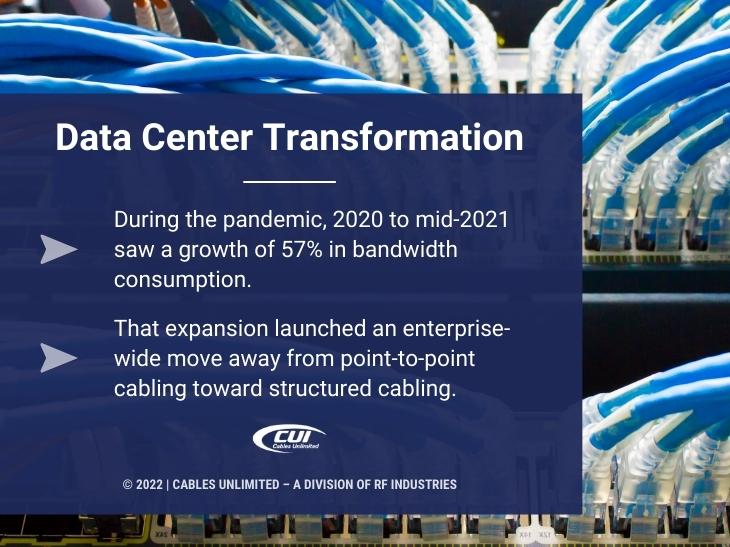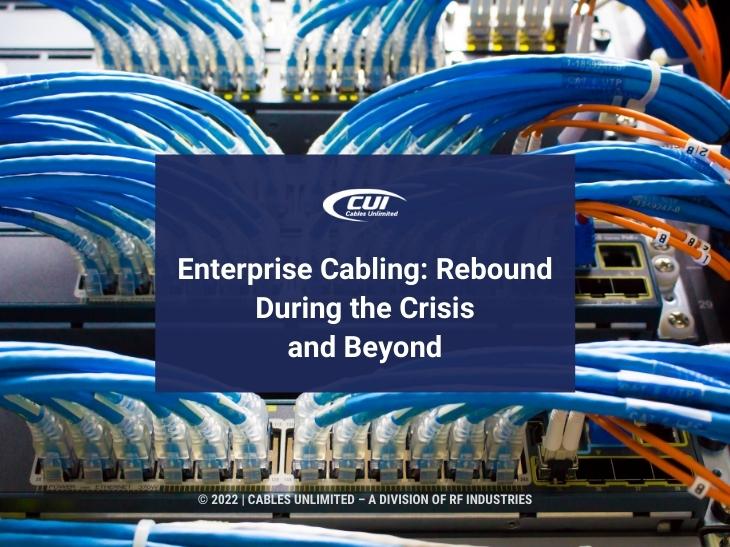The COVID-19 pandemic placed massive demand on broadband networks, starting with the very first days of lockdowns. Screen time from home skyrocketed for nearly every person on the planet. That meant the data flow almost wholly shifted from offices to homes. Enterprise cabling was at the heart of this transition, rebounding during and after the pandemic.
This rebound started before the pandemic with cloud data centers and structured cabling. It continues with yet another rebound in enterprise cabling to support the massive data flow changes that began with the pandemic and continue to this day. This article touches on the critical aspects of this fantastic rebound.
Data Center Transformation
Even though data center space and capacity doubled between 2010 and 2019, during the pandemic, it had to expand even further to support remote IT functions, increased e-commerce with all those purchases from home, as well as ever-expanding video streaming services. On top of that comes increased use of telemedicine, distance learning at every level of education, and the ubiquitous use of online conference tools.
As a couple of key data points to drive this point home, upstream bandwidth growth was 20% before the pandemic. During the pandemic, 2020 to mid-2021 saw a growth of 57% in bandwidth consumption.
Large cloud data centers were the key drivers of this transformation and, as a result, have become the standard for data center design. That expansion launched an enterprise-wide move away from point-to-point cabling toward structured cabling.

What is Structured Cabling?
Structured cabling is an organized cabling infrastructure that’s made up of standardized smaller elements. It offers predictable performance and flexibility for additions, changes, and moves. At the same time, it provides redundancy, maximizes system availability, and allows straightforward updates/upgrades.
The alternative is point-to-point cabling called top-of-rack deployment. Its downside is that it cannot support a modern virtualized environment with low-latency performance and scalability. Structured cabling, also called end-of-rack cabling, offers much-improved performance and ready upgrades across the data center. As just one example, fiber optic structured cabling also frees up the location of switches — from 100 meters to 10 kilometers!
Structured Cabling: Benefits to the Enterprise
As an enterprise data center transitions from point-to-point cabling to structured cabling due, for the most part, to increased demands, as outlined above. The benefits include:
- Increased flexibility in responding to changes from moves to expansion.
- Reduced downtime based on improved cable routing as well as limiting human error making point-to-point wiring changes.
- Improved organization in the data center and an improved look and feel.
- Savings in time and money for updates and troubleshooting.
Enterprise Cabling: What’s Next?
The pandemic certainly was a significant catalyst for change. But the following drivers of change will offer as many if not more challenges. From self-driving cars to 5G applications we haven’t yet contemplated, the Internet of Things will require low latency, high bandwidth, and scalability to meet ever-changing and expanding demands.

We Can Help
We produce enterprise cabling for all your applications. That includes custom fiber optic cables, hybrid cables merging fiber optics with copper, and networking cables.
If your requirements are already specified and ready for a quote, we are prepared to meet your deadlines and pricing targets. Our extensive in-house services and advanced manufacturing capabilities are in place to meet your requirements.
But we offer much more than state-of-the-art manufacturing – our dedicated team is also known for going to great lengths to meet the needs of our customers, including working round-the-clock to meet tight turnaround time requirements.
Our sales representatives are standing by to assist you with product questions and quotes Monday – Friday, 8:00 am to 5:00 pm Eastern. You can also send us an email or complete our contact form, and we’ll get right back to you.




